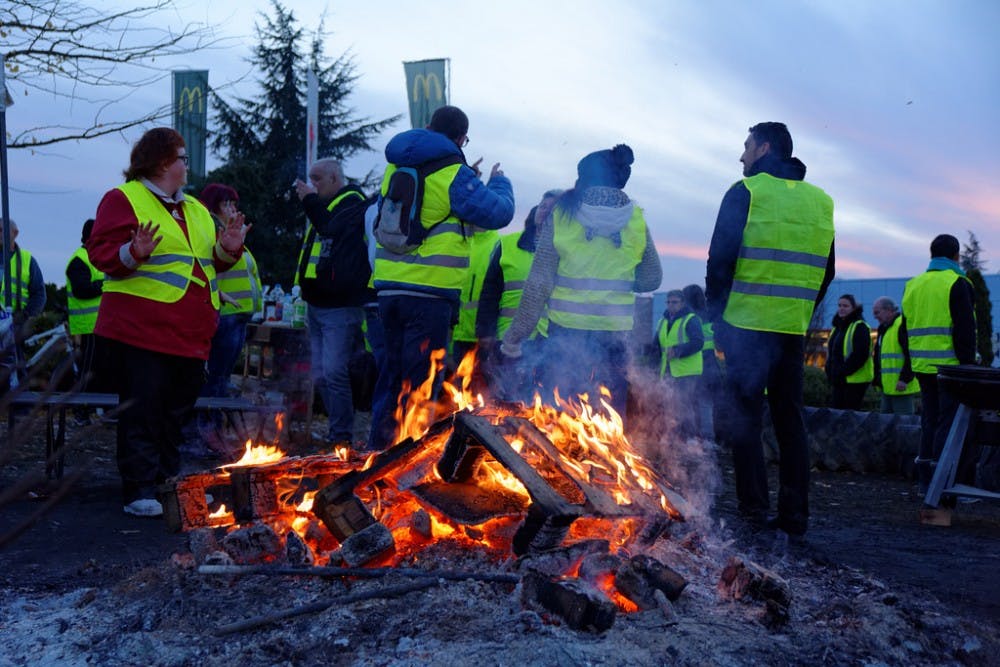This weekend I went to the Louvre. This was partly because I had work to do for a class I’m taking on 19th century French painting, and partly because I thought I wanted to write my next column about museums.
The French neoclassicism gallery at the Louvre is filled with canvases so big and so delicately painted that it feels almost as if you’re not careful you could walk right into one and leave this century behind entirely.
From certain windows in the Louvre, you can see the garden of the Tuileries, the l’arc de Triomphe du Carrousel, and beyond that, at the end of the Champs de l'Elysee, its more famous twin, l’Arc de Triomphe de l’Etoile.
Most of the time it’s a peaceful view, stately even. The Paris of film and imagination and “La Vie en Rose.” But for the past two weeks that view as been obscured with smoke and blocked by police barricades.
Protests over increased fuel taxes by a movement called “the Gilets Jaunes” have morphed into violent riots. Protesters have burned cars and looted store fronts. The police have fired tear gas and water cannons. This Saturday the protesters overtook the Champs-Elysees. They graffitied the Arc de Triomphe and vandalized the tomb of the unknown soldier. Near the Louvre, they pulled the gates of the Tuileries down.
But the violence of the “Gilets Jaunes” protests are merely the most eye-catching part of the problem. Something important is happening in Paris right now. It’s the center of a movement that’s sweeping across France and is tied larger economic trends across the world.
The Gilets Jaunes movement began as a protests against fuel taxes that were put in place with the intention to slow climate change. But many felt that these taxes disproportionately placed the burden on lower and middle income people who are much more likely to live outside of cities in France. There’s a feeling that President Macron is governing to protect the interests of the rich, while lower and middle class French people are left behind.
And as always, behind economic uncertainty there rests the insinuation of other types of grievances. There have been accusations that demonstrations have been infiltrated by both the extreme left and the extreme right, as well as by rioters who are seeking to provoke violence.
SEE MORE FROM REBECCA ALIFIMOFF:

This weekend I slunk around the city avoiding protests that I could only half understand. I did my homework. I bought coffee. I went out. My high-handed thoughts on a column about art drifted around my head.
Originally, I was going to say that to hold art to the standards of the profound and the sublime is absurd. The best art is a reflection of the human condition, and therefore holds within it the profound and the absurd. So in order to be engaged in art we don’t have to search for some great movement of emotion to seize us, but rather be engaged, even if that engagement comes in the form of small and quotidian examples. Even if comes in the form of selfies in front of art and attachment to small, absurd details.
I wanted to say: Get out of the classroom! Enjoy art! Feel great about it or feel bad about it! Take a million selfies in front of “Liberty Leading the People to Freedom” or don’t. Compare Renaissance portraits to Kim Kardashian’s selfies, but do something. Get your hands dirty. Be engaged in this thing that often feels elitist and removed.
But when it came to it, all of that felt silly. It felt disingenuous to not acknowledge that something is going on here, even if it’s something that I don’t understand and don’t quite have a way of engaging with.
Sometimes this whole liberal arts education thing that I’m doing here seems almost sacred and important. And sometimes it feels like a deliberate act of disengagement with the world.
As this week continues, Paris will move on. President Macron has called meetings to address the continued unrest. The glass will be swept up and the burnt cars will be hauled away. The anger will stay. The Gilets Jaunes have promised to keep protesting every Saturday until things change.
The neoclassical gallery has no windows, and it will stay as unchanged as it has for 200 years.

REBECCA ALIFIMOFF is a College sophomore from Fort Wayne, Ind. studying history. Her email address is ralif@sas.upenn.edu.
SEE MORE FROM REBECCA ALIFIMOFF:









